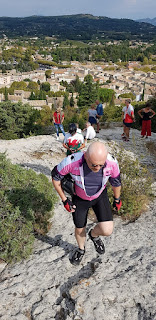The Challenge of Mont Ventoux
Mont Ventoux stands alone in Provence dominating the skyline and looming ahead no matter from which direction you approach it. The “Giant of Provence” is 6,273 feet high with two distinct parts. The first half is tree-lined, shaded with dappled sunlight but then just before Le Chalet Reynard the trees disappear exposing a bare limestone mountain with no vegetation. From a distance, it appears to be snow-capped all year around giving Ventoux another of its nicknames, “The Bald Mountain”.Chalet Reynard, a former refuge, is now a restaurant that at 4,649 feet is a welcome drink and food stop for cyclists to re-fuel before facing the final miles of the ascent.
Mont Ventoux's iconic reputation is built not just on its unique nature but also the exploits of riders during the month-long celebration of cycling and extreme sporting exploits that is the Tour De France. Used more sparingly than some other climbs like Alpe D'Huez, it is the epic and sometimes tragic nature of the stages that make it the most iconic of all mountains.
Whether it is Lance Armstrong and Marco Pantani’s drug-fuelled duel up the climb; Eddy Merckx’s victory on the summit requiring oxygen to recover; Chris Froome spinning away from his rivals to set up his first tour win or running up the mountain looking for a bike Mont Ventoux never fails to be a spectacle.
However, the ride that tragically did most to cement its iconic status was in 1967.
Tom’s strength had always been the one-day races and the Tour de France had not been kind to him. He had started six times and only finished twice but the Tour was the biggest shop window and with retirement coming in a few years he needed to finish and finish well to secure a lucrative contract. Winning the Tour would set him up for life.
The race started well for Tom and after the first week he was well placed at sixth and ahead of all his main rivals but as the race went into the Alps he fell ill with diarrhoea and stomach pains. He began to drop back and after stage 12 teammates were advising him to quit the race. But Tom was determined to go on.
Stage 13 on the 13th July was a 134-mile route from Marseille to Carpentras going over Mont Ventoux just before the finish. In searing heat, the climb started and at first, Simpson managed to stay close to the front of the race but then he began to slip back and zigzag across the road. Less than a mile from the top he fell off his bike. People tried to persuade him to stop but Tom was having none of it. He was helped back onto his bike and they pushed him away, “On, On, On” Simpson said as he continued.

These turned out to be his last words as after riding another 500 yards he began to wobble and three spectators ran over to assist and help him to the ground. He was unconscious and they had to pry his hands off the handlebars. Despite mouth to mouth resuscitation on the mountainside he was pronounced dead at 5.40pm. At the autopsy amphetamines and alcohol were found in his system.
A string of issues lead to Tom's death: his illness the day before, the searing heat, the stress of feeling the need to go on regardless and the drugs and alcohol that he thought would give him a little extra. Perhaps there was another factor in that he failed to give the mountain the required level of respect. As the champion cyclist, Raphaël Géminiani put it “Ventoux, cette montagne n'est pas comme les autres”
A granite memorial now stands at the spot where he collapsed just below the summit. When I ride up Ventoux I will stop at the memorial and remember a man who gave everything on the mountain and reflect on the words of French philosopher and bicycle fan Roland Barthes.
“The Ventoux is a god of evil, to which sacrifices must be made. It never forgives weakness and extracts an unfair tribute of suffering"

Comments
Post a Comment